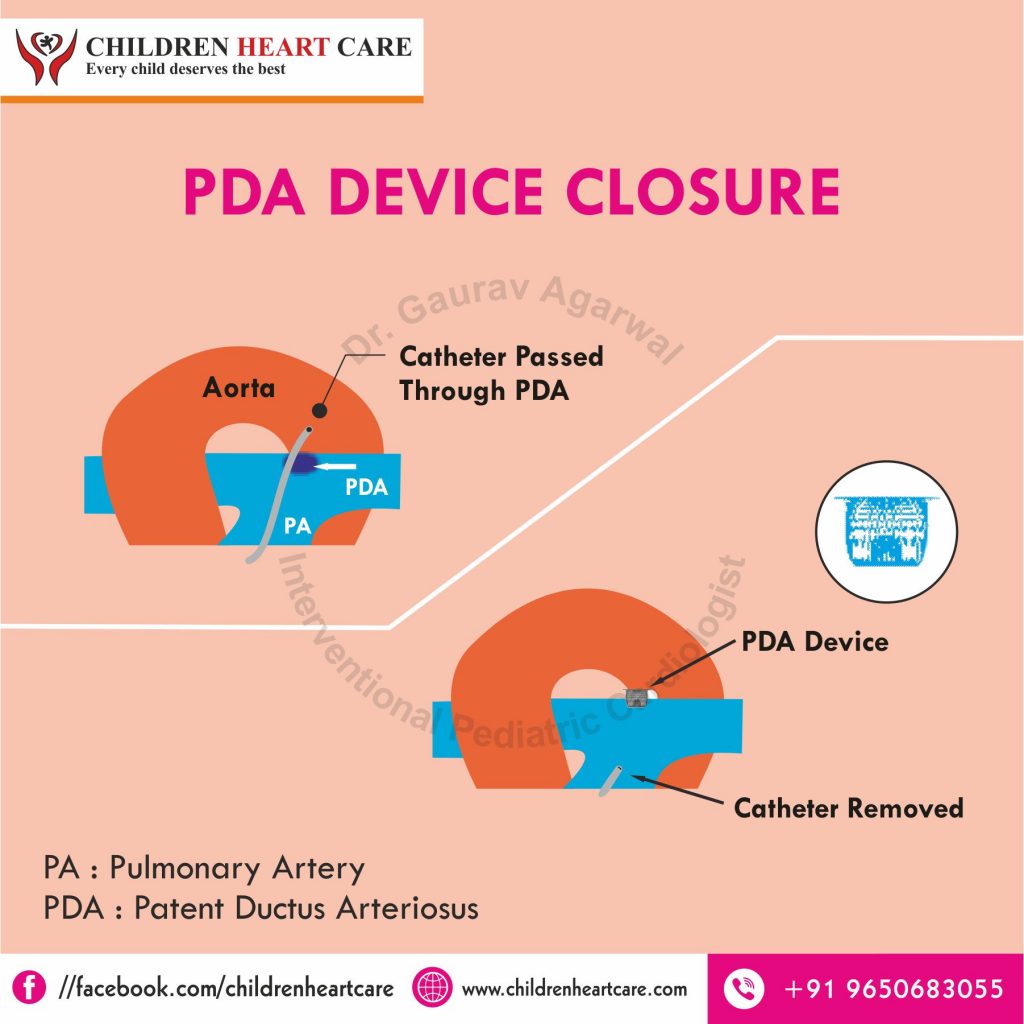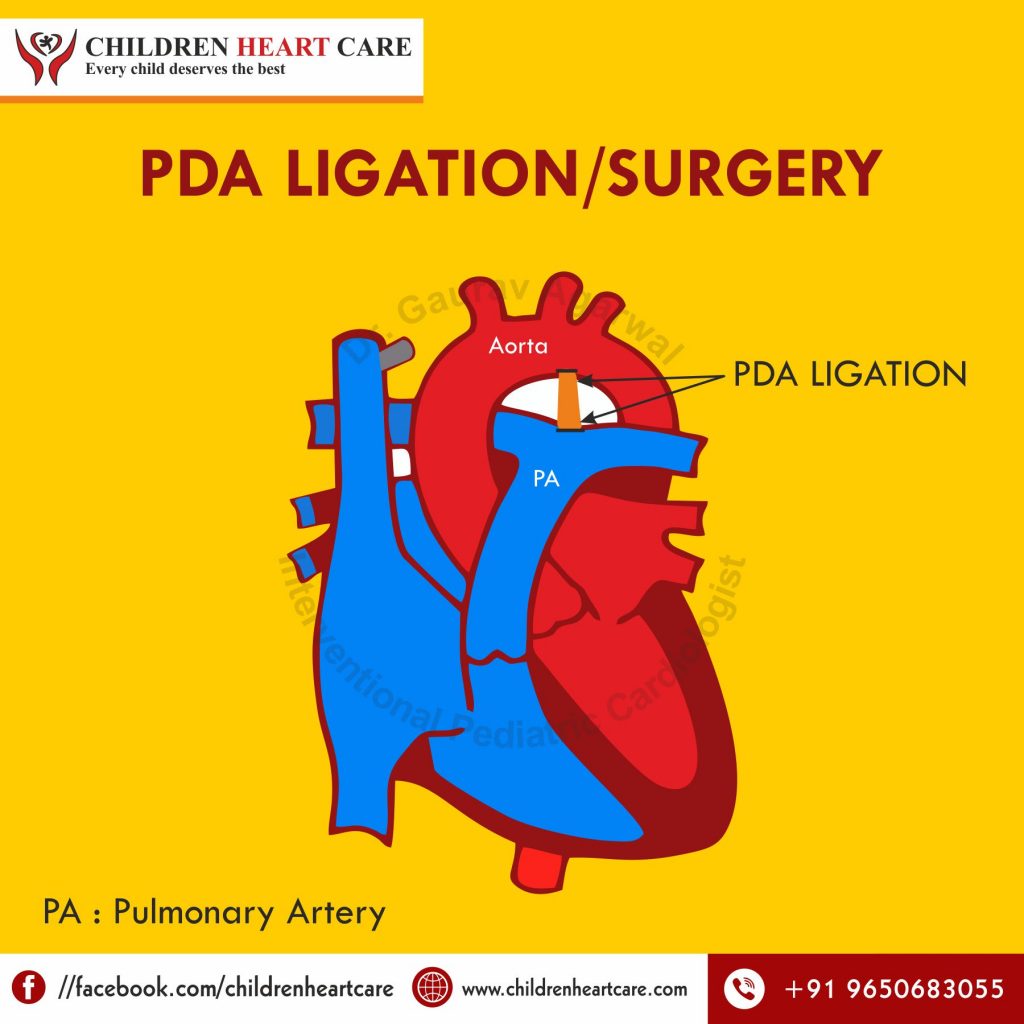Common Cardiac Conditions
- ASD Surgery in Delhi
- VSD Surgery in Children in Delhi
- Best PDA Surgery in Delhi
- Coarctation of Aorta Treatment in Delhi
- Aortic Stenosis Treatment in Delhi
- Pulmonary Stenosis
- Atrio-Ventricular Septal Defect (AVSD/AVCD)
- RSOV Treatment in Delhi
- Eisenmenger Syndrome/ Complex
- Tetralogy of Fallot Treatment
- Transposition of Great Arteries (d-TGA)
- Total anomalous pulmonary venous connection treatment in Delhi
- Truncus Arteriosus
- Tricuspid Atresia
- Double Outlet Ventricle
- Congenitally Corrected Transposition of great vessels in Delhi
- Ebstein’s Anomaly
- Pulmonart Atresia (PA) Without VSD/Intact Septum
- Pulmonart Atresia (PA) with VSD
- Hypoplastic Left Heart Syndrome
- Stenosis of Pulmonary Artery Branches
- Patent Foramen Ovale (PFO)
- AP Window Device Closure
- Vascular Rings
- Interrupted Aortic Arch (IAA)
- Bicuspid Aortic Valve Treatment
- SVT treatment in children
Patent ductus arteriosus (PDA)
- While every parent wants their children to be born healthy, some infants have a range of disorders present at the time of birth.
- Patent Ductus Arteriosus or PDA is one such condition that manifests in children when they are born.
Q: What is a PDA?
A: PDA is the opening between the two major blood vessels leaving from the human heart. The ductus arteriosus is an essential part of a child’s circulatory system before birth in the form of ductus arteriosus.
This vessel closes a few days post the birth of the child, as the same functionality is now performed by the infant’s lungs. However, if the ductus arteriosus stays open after birth, it is called a patent ductus arteriosus (PDA).
Q: What is preterm PDA and what are the outcomes of it?
A: Preterm PDAs are having less muscles and less prone for spontaneous closure as compared to term PDA.
Preterm babies are less able to tolerate PDA effects as compared to term babies so may require early closure
Q: Can we close PDA by medications?
A: Yes, but only in premature babies.
Q: Symptoms of PDA (PDA symptoms, Patent ductus arteriosus symptoms)?
A: The symptoms of the patent ductus arteriosus depends on age and weight of the child/baby.
In the case of larger PDA, here are some common symptoms and signs:
- Frequent cough and cold
- Hospital admissions for pneumonia
- Your child will sweat when he/she cries or eats
- Your baby will tired easily
- Your baby’s heart rate will be elevated
- Your baby will experience breathlessness
- PDA murmur on examination of the child
In small sized PDA: Child will be asymptomatic.
In moderate sized PDA: child will have symptoms as mentioned in case of large PDA but will be of less severity.
Q: Causes of Patent Ductus Arteriosus?
A: There is no clear cause for persistence of PDA after birth. Doctors have yet to pinpoint the exact reason why some children are born with congenital heart diseases, such as PDA.
As ductus arteriosus is a normal fetal heart structure that connects aorta (main blood vessel of heart that supplies pure blood to the body) to artery of the lung known as pulmonary artery, each neonate born with ductus arteriosus. Soon after birth, this opening is no longer needed in a normal neonate and usually closed in first few days preferably within 48 hours of life.
But occasionally, it does not close as persist as patent ductus arteriosus. It mainly occurs in immature babies (preterm babies) and rare in full-term babies.
Some theory believes that genetic factors may play a role in causing PDA in a child.
Infection of mother during pregnancy by Rubella virus can lead to persistent PDA in the child.
Q: Risk factors for PDA?
A: These include:
- Premature birth of the newborn as PDA is more common in premature babies.
- If there is a family history of heart defects etc then very high chances of having a PDA.
- Pregnancy affected by Rubella infection
- If baby is born at high altitude
- Females are more prone to have patent ductus arteriosus.
Q: How to diagnose patent ductus arteriosus (Diagnosis of PDA)?
A: PDA can be suspected by family physicians when they hear PDA murmur on examination of the child. PDA can be confirmed by doing Pediatric Echocardiogram (children echocardiogram).
- Echocardiogram: Done form the chest of the child by echo probe. A non-invasive test.
- Chest X-ray and ECG helps in making the diagnosis of PDA.
- Cardiac catheterization: It is generally not required for making the diagnosis of PDA. It is required when we need to assess pressures in the lung or when we are planning to perform PDA closure by catheter technique.
Q: Indication of closure of patent ductus arteriosus (PDA closure indictaions)?
A: In most cases, the PDA remains small enough not to cause any complications. However, if this vessel becomes too big, it can cause excess blood flow into both lungs and if not treated in proper time then poorly oxygenated blood can flow from lungs to the body and cause bluish-black discolouration of lips and fingers (Eisenmenger PDA).
Excess blood flow to the lungs leads to frequent cough & cold, respiratory distress, weight loss or poor weight gain etc (Heart failure).
Q: Treatments for PDA (PDA treatment)?
A: Doctors have to account age and weight of the child while planning management of PDA.
Here are some options open to you if your child suffers from PDA.
PRETERM PDA-
- Patience- If PDA affects your premature baby; the doctor will wait and watch whether the PDA closes on its own.
- Medications- In case of a premature child with PDA, doctors also prescribe certain non-steroidal anti-inflammatory drugs like brufen/paracetamol etc to aid in closing the PDA if non-pharmacological measures alone not sufficient to close the PDA.
If preterm baby is not responding to conservative or drug therapy and dependent on oxygen or any respiratory support or in heart failure, then PDA should be closed (patent ductus aretriosus surgery).
Surgery is done from left sided back of the child/baby (PDA ligation/surgical closure).
In preterm babies: either surgery or now a day, device closure technique can also be done in cath lab (without surgery) known as PDA device closure.
PDA surgery cost is reasonable now a day in India and success rate after PDA surgery is very high (PDA surgery success rate) and recovery time after PDA surgery is very good.
PDA surgery complications are rare now a day.
PDA in fully matured babies (Term Babies):
Drug treatment is not effective in closing the PDA in fully matured babies.
When baby showed signs of heart failure or in respiratory distress then medical therapy in the form of diuretics are prescribed for decreasing the signs of heart failure.
Timing of Patent Ductus Arteriosus (PDA) closure?
- If PDA is large in size then PDA surgical ligation needs to be done between 3-6 months of age.
- If PDA is small in size (child is asymptomatic in small PDA): PDA needs to be closed between 12-18 months of age by non-surgical method in the form of PDA device closure in cath lab by angiography.
- Moderate sized PDA children are having poor weight gain and show signs of heart failure but less as compared to large PDA. These PDA needs to be followed up to 9-12 months of age and needs to closed preferably by device technique (non-surgical) depending on size of PDA and weight of the child.
Q: How are PDAs closed in the cath lab?
A: As adult cardiologists are performing cardiac angiography by using thigh blood vessels that are connected with the heart, we also use the same vessels for closing PDA in cardiac cath lab in a beating heart. This method of closure of PDAs does not produce scar on the chest.
For closing by the device, size of PDA, weight of child has to be taken in consideration. This procedure is generally done under conscious sedation. Patient can be discharged on next day and can perform daily activities without any fear. Within six months, device become endothelized and become a part of heart for life long. There is no need of medications after the procedure.
Q: Ongoing Care required for patent ductus arteriosus?
Medical Follow-up
- This is generally done in cases of small or silent PDA only.
- Child who underwent PDA closure “rarely” require long term pediatric cardiology follow-up if not associated with other heart defects.
Activity Restrictions
- There is no need of special precautions required with small unrepaired PDA or a repaired PDA and can do all sports activities.
- After surgery or catheter closure, only few days’ mild limitation in activities is advised.
- Exercise restriction is advised for that patient who is having high lung pressures (pulmonary hypertension) due to PDA.
Infective Endocarditis Prevention/prophylaxis
- IE prophylaxis is recommended only for 6 months after catheter/surgical closure of patent ductus arteriosus.
Pregnancy and PDA
- Pregnancy is considered a low risk if PDA is not associated with signs of heart failure or pulmonary hypertension.
- Large PDA affected pregnancies can have signs of heart failure, heart beat problems (arrhythmias) or may have pulmonary hypertension: these all can increase risk of complications during pregnancy.
- In inoperable PDA: pregnancy should be avoided (PDA Eisenmenger).
Will You Need More Surgery after PDA surgery?
- It is very rare that re-surgery for PDA is required.
- Only recommended when there is residual hole after previous surgery and that too is significant in size.
So if you're looking for Best PDA Surgery in Delhi, Contact Dr. Gaurav Agrawal today.
PDA
PDA
PDA




